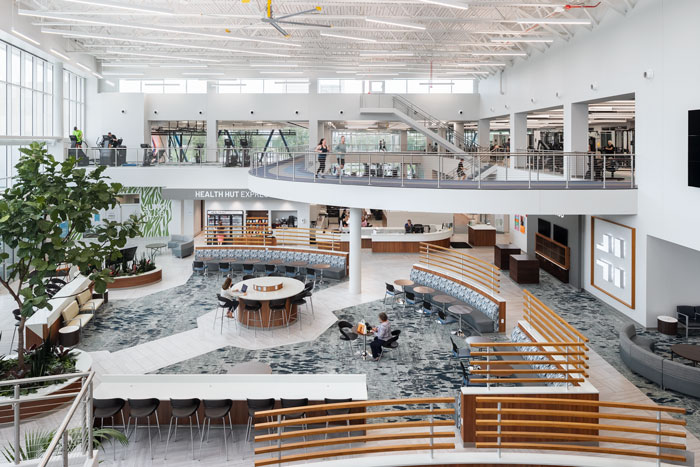This year marked a milestone event in world history—the four-year anniversary date (March 11, 2024) of the World Health Organization first declaring COVID-19 a pandemic.
Stephen Springs, senior principal, Brinkley Sargent Wiginton, recalled a project he was working on at that time in Keller, Texas: the Keller Senior Activities Center. “It was near the design phase when COVID-19 was named a pandemic,” he said. “Everything stopped, as was the case with construction activity almost everywhere. We kept designing and finally broke ground in October 2020. Supply chains continued to present challenges during construction. The ribbon was cut in January 2022.”
At the onset of the pandemic, besides construction issues, people were advised to isolate, maintain social distance and
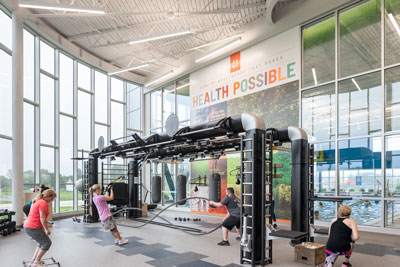
wear masks. Change over the ensuing four years has been inevitable—and welcome, said several recreation center designers. And although construction costs as well as the overall costs of doing business have risen, communities now want either new, ground-up, technologically and artistically sophisticated recreation and wellness centers, renovated spaces, or add-ons to their existing structures. Regarding rec center programming, other relevant changes since COVID include how we recreate and interact with one another and becoming more inclusive.
Post-pandemic, we continue to question how we engage with the community, noted Brent Ross, practice leader, senior associate, Perkins & Will. “That has changed—for the better, I think. Despite all the changes resulting from the pandemic, some things remained tried and true,” Ross insisted. “For park districts and park departments, they are looking to appeal to a broad base of their community and so spaces that are well-utilized and answer to most people are gymnasiums and conventional fitness centers. There is always a need for indoor walking space, at least in the upper (northern) climates. Those are the items we see in the most high demand and serve as the core of a recreational-type facility.”
The other functions and programs people ask for, Ross continued, are very site-specific and depend on the community, what is there and the demographics. All play a role in determining the mix of programs at a community center or recreation center. “I almost feel like recreation and wellness centers are working to combat isolation,” he said. “The whole goal around these facilities is to bring people together from all different walks of life and to give them a community resource to help improve their own lives and their family’s lives.
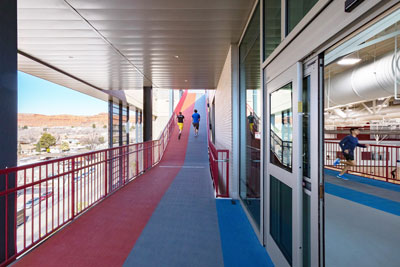
“Post-COVID there is a comfort level in getting together,” Ross said, and these facilities want to encourage
that activity as much as possible. Group fitness is fun. There are always trends in group fitness, whether old-school jazzercise or Zumba. Exercising with a trained professional leading the group and bringing a lot of energy, being with your friends and finding a sense of community within that space is always attractive. More often than not, that is drawing people to a center—to get that sense of community around fitness.”
Agreeing with Ross is Sam Elsheikh, senior principal, Ohlson Lavoie Corp. (OLC). There is more emphasis on getting together in community rooms, he said, and having stuff to do together, such as senior rooms or arts and crafts. Activities that engage more than one person versus the old days, and having fitness floors or spaces where you could have your headset on and be in your zone, do your thing and go home.
“We see where communities need interaction, the connectivity that we missed due to the pandemic,” he said. “Classes that get people together in the same room for exercise are popular. People have been away from each other for so long that they are looking for group wellness activities; spaces that can accommodate groups of different sizes for yoga, Pilates, or Zumba.”
Cost Recovery & ROI
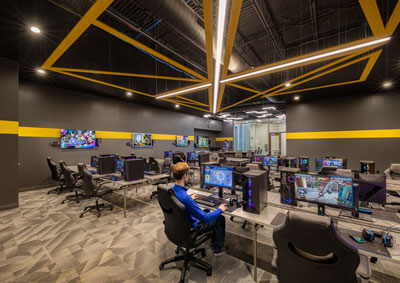
“What we are seeing in our client base is a lot more focus on cost recovery,” Springs observed as a major trend. “That is
not necessarily a new thing, but it is very much a growing thing, and we are finding it is becoming more of a premise in design, as opposed to trying to apply goals of cost recovery to an existing operation, which is a bit harder. We are seeing that desire from the clients we are helping. To the extent that means full cost recovery or just high cost recovery or more than what they are used to—there is a range there.”
For many clients, cost recovery really means operational costs. It doesn’t mean debt service like it would in the private sector, Springs said. “Typically, the capital to build the rec center is funded by a bond election or something of that nature. Cost recovery is what it takes to pay for staffing and utilities. Our focus as designers is what will make this facility distinguishable in whatever way to help drive that revenue.”
When a recreation center is design-based, Springs said, “a client or stakeholder might say ‘here is the program, here is what we want to do,’ and that’s fine. But we also have clients who say, ‘We know we have a need. We need help defining what that need is and what the scope of that project is.’ The process of doing public engagement and doing pro forma planning is more and more common in our client base.”
New Builds vs. Renovations
New builds are trending for Springs’ client base. “We are in a very high-growth area,” he said. “Our market is
predominantly Texas, although we do some work in other states. But Texas has been experiencing tremendous growth for some time. And is continuing to do so. Growth itself is funding and driving a lot of new builds in this market. We are involved in some additions and renovations, but the new builds are where most of the work is.”
Along with new builds, clients are wanting aquatics in the space, although aquatics can be a bit of a heavier lift, especially indoor aquatics, Springs said. “It’s expensive square footage. We are still seeing it become a more common piece of our rebuilds. Whereas before it might have been high on the desired list but maybe not fundable. Or maybe it’s master-planned as really nice to have, ‘but we really don’t have to have it.’ Now, it’s what clients want.
“A project we are about to kick off is a VFW, where it is an older recreation center with a much older outdoor pool that has lived its life,” Springs said. “They want to tear out the old outdoor pool and build a new indoor pool as an addition to the rec center. They don’t have a lot of cost-recovery goals. Irving, Texas, is a more mature city that has existing centers that have very low price points to participate in and can’t adjust that price point very easily. That would be politically very challenging. That said, they are putting some significant dollars into renovating it for future-generation users.”
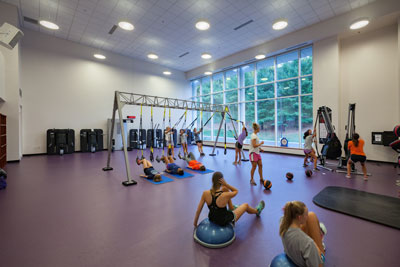
Elsheikh said he is seeing both new builds and renovations. Facilities like YMCAs and private fitness facilities are mostly remodeled, he said. “Everybody has sticker shock. The private sectors and Ys need to make money to sustain the facility and not rely on taxpayer money. They had rough times during COVID and are just recovering, and they are starting to think that they need to expand. They look at construction costs, and an older business plan doesn’t work as well anymore.”
Erik Kocher, design principal, Hastings & Chivetta, said “a trend we are seeing more of is vertical facilities. In previous years we would do a one-story or maybe two-story facility with a jogging track on the second level. But we are doing many more urban and small-site facilities where they are now three, four, six stories high.” Those facilities have outdoor spaces as well, but they are captured in outdoor balconies or terraces, he said.
“We did one not too long ago, which opened after COVID by chance, where we used the entire roof as an outdoor activities space,” Kocher said. “It’s the idea that building new indoor space can be very expensive. So if you have this opportunity to add on to your building we can capture some of this outdoor space and this comes at a reduced cost. You are still inside the building, and it’s in your control. You go up to the roof or the terrace or wherever you work out, but you still come in through the front door of the facility as a member. We are seeing more rooftop spaces as part of a facility. It seems like at colleges, the kids migrate to them because it is pretty cool when the weather permits and it’s nice to be working out outside.”
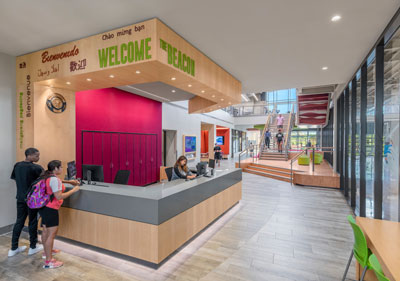
If you’re looking for something new and creative in the fitness space, Kocher’s design team at Hastings & Chivetta has an idea: changing elevation on walking and jogging tracks. “There are thousands of facilities with tracks suspended in the gym,” he said, “but we have one now where we change elevations. It is not like you are climbing hills, but in the context of running around the gym you go up and down rather than walking around on a flat surface.
“We have one project,” Kocher explained, “where you can run around indoors and (like a sliding door at a grocery store) run outdoors up a big ramp and then on to a roof. We are starting to see some more fun things like that to keep people excited. I can’t say this is a trend, but I think we are the only firm that has ever designed a four-story stadium step. You go from the ground floor of the facility all the way up to a jogging track on the upper level. Some people will jog around the building, go back down and then take steps back up. This creates another kind of fun activity.”
Flexibility in Design & Programming
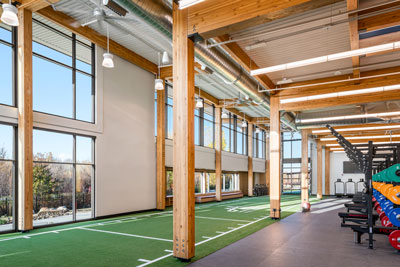
Flexibility is definitely important in modern-day recreation and wellness centers, Elsheikh said, “because what is in fashion now may not be in two or three years.
“So all our community centers have group exercise spaces, which we call multipurpose rooms. In the old days we had dedicated rooms for yoga, and a group exercise room that used a cushion on a wooden floor. Everybody is moving away from that to a vinyl flooring cover for multipurpose rooms that can be used for meetings or other activities.”
Maximizing participation to increase the value of the recreation center to the community is a trend, said Connie Osborn, associate project manager, Barker Rinker Seacat. “When we do our public engagement process at the outset of a project, we think about it from the perspective of whose needs are not being met. We dig into that. I often mention that indoor-outdoor connection is a lifestyle trend and starts to meet the needs of those who prefer the air and the sunshine and the trees, and the sense of being outside.”
But Osborm also finds that meeting community needs means being flexible, and one of the best ways you can achieve that flexibility is to provide support spaces that complement other programs. “And by ‘supporting’ spaces,” she explained, “I’m thinking of something simple like storage.”
Providing more storage allows for the equipment, furniture and the props that are needed to create a programming experience that might be emerging. “Oftentimes the design community will sacrifice storage space to maximize the program space, but without the right kind and properly located storage space you do limit what the program space can do.”
“Everything we do must have flexibility,” said Elsheikh, agreeing with Osborn. “Our recreation centers will have a gathering space like a banquet room, and a room that can be divided into two or three rooms where different groups can function at the same time.
“Take pickleball. It’s very popular and it seems like everybody is planning to convert spaces to pickleball or to build pickleball facilities. But is it a fad or will it endure? Nobody knows. So when we design right now, such as at a YMCA, we design the pickleball court in a way that if pickleball proves to be a short-lived attraction, we can convert it to either a basketball or tennis court.”
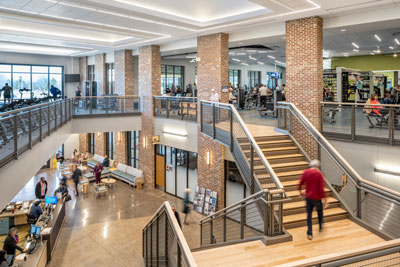
Sometimes you want to create a “wow” factor, but you want to do it in a way that doesn’t overwhelm the facility versus one that can serve multiple functions and programming, Elsheikh suggested. “You’d like the wow effect without compromising everything else. The ‘wow’ factor shouldn’t take up a lot of square footage, and shouldn’t compromise the rest of your programming.”
Having multi-use flexible spaces is very much a part of any design, Springs said. “One thing about parks and recreation programming is that it is very dynamic. There is always a new idea for a new program beyond just the trendiness of different kinds of exercise.”
Fitness needs to be flexible as well, with fitness spaces laid out in such a way that they could be expanded. “I have been doing this long enough to come back and help clients years later renovate and expand and that’s always the space they want to make bigger,” Springs said. “If you can lay it out from the beginning in such a manner that it can be relatively easily added on to or expanded, that is a very valuable premise for most projects.”
But flexibility cuts both ways, Ross said, offering a warning: You can design a space that is so multi-useful that it becomes multi-useless. “It’s really about not getting too generic with the spaces that they don’t address special programs really well. We’ve all learned our lesson with the racquetball courts of yesteryear, with walls that have become very difficult. We recognize that we live in a world of social media and people can learn about trends very quickly, and sometimes that puts pressure very quickly on recreation operators to demolish and modify and is very expensive. We want to make sure our spaces can support the programs and fit what they are trying to do today, while not necessarily cutting them off from being modified and opened up in the future.”
New Worlds in Programming
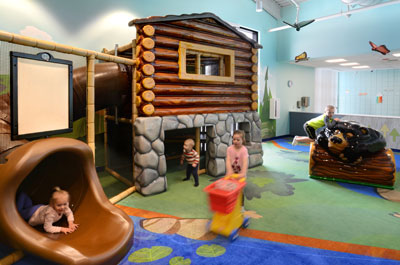
These days, community rec and wellness centers might have to account for esports and gaming in general if they want to
be relevant to a wider and younger demographic. At university rec centers, Ys and almost everywhere else, the amount of socialization that is done through gaming is unbelievable, Ross said. “It is something new and different that older generations didn’t have, so I think it is here to stay. It’s a way to connect over a shared activity, have fun and make some memories. Esports is a big trend among schools and universities as a way to expand their brand or, from a recreation standpoint, a way to bring more people into a social setting, out of the dorm rooms and out of isolation.
“This is in line with what most rec centers do too—they want to serve the most people, and while they might not be elite gamers, they can get into the space and into the games, socialize through them and find a sense of community,” Ross said.
Kocher and his team have done seven or eight esports suites in rec centers for those at the high school and collegiate level.
Advantages to Partnering
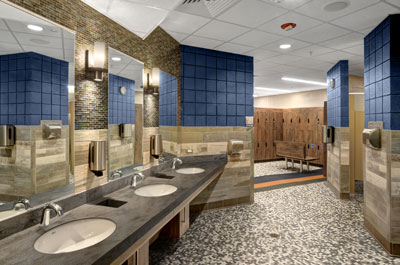
Elsheikh is seeing more medical fitness projects, particularly in Florida. “We are getting inquiries from hospital groups that want to develop wellness centers. That is an area that is developing again.”
He is also working with Ys that have relationships with local hospitals, where they might have a physical therapist within the Y. “It’s like these entities are teaming up to find the right mix of programming and services that they can offer their clients and attract more clients.”
Following the trend of recreation centers becoming more community-focused and finding ways to fill gaps in community needs, many municipalities are recognizing the opportunities for offering a variety of programs that happen under one roof—city services, libraries and other outreach programs that can live alongside all of the programming that the park districts have traditionally offered.
Ross also is working with healthcare partners “who want their brand to penetrate the community and so their mission is aligned with recreation centers.”
With the economic climate, this also helps a lot of facilities get funded and built. “Traditionally these centers were only funded by referendum and tax. It was a quality-of-life issue. There are still the same needs there, but there are so many different avenues to fund these projects, through foundations and grants, partnerships and also just pooling money between different city departments.”
Fast Forward: VR, AI & Technology
You’ll always need to accommodate technology. “It wasn’t all that long ago that one of the biggest challenges in the buildings was figuring out how to get it cabled, like at a fitness center,” Springs said. “Then came wireless technologies, and suddenly you didn’t need hard-cabled equipment. You could just put it all on a wireless, although we still have to contend with power. Soon after that, the on-board wizardry has changed and everybody’s coming to their treadmill or their workout not necessarily wanting to be entertained by the machine but being entertained by their iPad. They are bringing technology with them.”
“I’m not a futurist,” Kocher said, “but someday, you won’t have to wear glasses or goggles to get the virtual reality experience. Maybe it will be contacts that can provide you with a visual experience as you are working out. The days of being on a spin bike where you are looking at either a monitor or a projected screen, where you are hiking through the alps…you might not need the clumsy headgear of VR, rather than looking at a screen—just looking through your eyes.”
“I’ve been doing some research on artificial intelligence (AI),” Springs said. “As an architect, how is AI applying to design? What is available right now is rendering. There is a lot of AI imagery going on and an ability to speed up that process.”
How will AI impact design? “Right now it makes pretty pictures,” Springs said. “There is much happening in that world, but I don’t think any of it I’ve seen is ready for primetime. It’s not very practical yet, but I suspect it is not too far around the corner. Spec writing is not a sexy part of design, but I think that is coming very soon. Imaging buildings for example. So, from a specification standpoint I can see that making sense because it fits into that language modeling algorithm. I’ve seen some crude beginnings using AI for space planning.
“But as that applies to rec centers, I’m not sure how useful that could be. AI is still maturing and will have to go through a couple of iterations of that maturation before we are seeing it become a staple in our office.” RM



